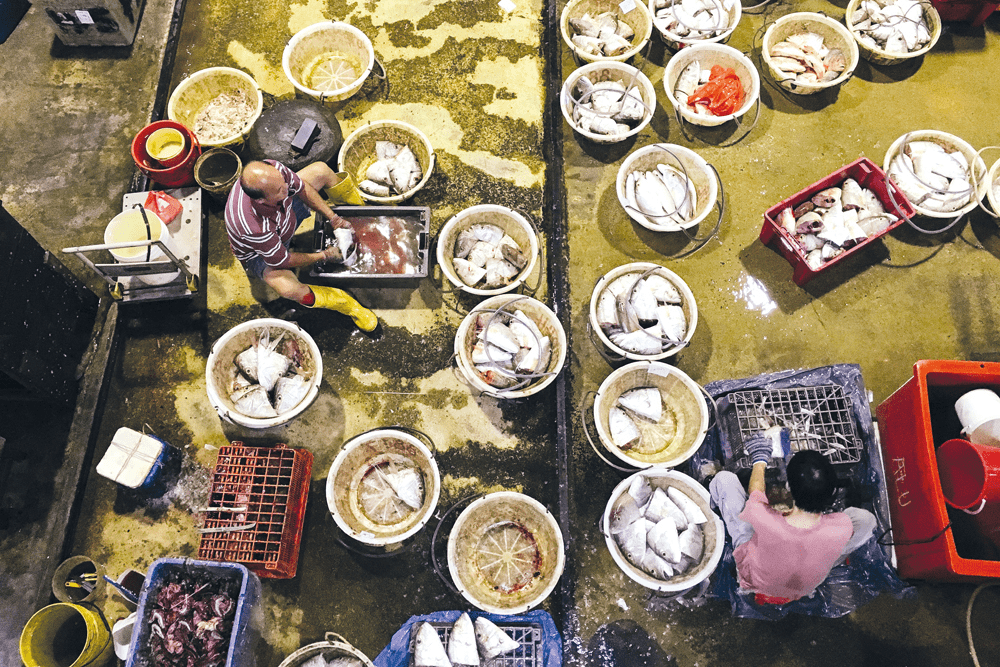Let’s not forget what came before the fish trawler—the sampan.
When I say “Fish market”, what comes to your mind? Most of us would think of Tsukiji Fish Market, the biggest wholesale fish and seafood market in the world.
The bustling crowd of restaurants owners and fishermen in the wee hours of the morning, the rumble of trucks droning in and out of the loading bay, and the intense fish auctions where bluefin tuna auction bids once went as high as US$632,000
Did you know you could find all of these in Singapore too? Well, frankly except for the US$632,000 whole bluefin tuna, and no, I’m not referring to the Merlion.
Jurong Fishery Port
With a small fishing industry in Singapore, there must be a place where all our seafood imports from all over the world congregate right? Since 1969, that place for us has been at Jurong Fishery Port.
In operation since 1969, Jurong Fishery Port comprises mainly of a 400m long wharf for fishing vessels, and a 9,000m2 wholesale fish market which houses over 110 market lots.
In addition, facilities such as computerized water batching systems which dispenses clean drinking water to the vessels, canteens and ice-crusher stalls come together to serve both the consumers and suppliers well.
With the exception of their rest day on Monday, the international port is opened in the wee hours of the morning from 12am – 6am, from Tuesdays to Sundays.
The port comes to life from 1am – 4am, where the large, open space becomes dominated by over 3,000 local wholesalers and eager customers, all seeking the freshest seafood the world has to provide.
All in all, there are 103 Agri-Food & Veterinary Authority of Singapore Licensed fish merchants who conduct their wholesale fish business at the port
The Hustle and Bustle
With busy fishermen busying on their grind and cartloads of seafood darting around, it takes awhile to get used to the environment when you too, have your feet soaked in cold, salty seawater.
Here, you purchase your seafood directly from the fishermen themselves, through the loud fishmongers stationed in the 110 market lots made available for them to conduct their business. Everyday, over 250 tonnes of seafood is purchased; Squid, Mackerel, Pomfret, Seabass, Trout, Crabs, Snappers, you name it, they have it.
More importantly, because the fish isn’t coming from a middleman such as a wholesaler, you can be sure that you are getting the most bang for your buck.
A 50 year-old local, Mr Amir Mohd Ariff, told TNP that one can save up to $4 by choosing to purchase his/her fish from Jurong Fishery Port instead of heartland wet markets.
Local wholesalers are the busiest around 2am, purchasing tonnes of seafood in bulk, for redistribution to local supermarkets and wet markets.
The seafood that are sold at Jurong Fishery Port generally come from sea from Indonesia, land from Malaysia and Thailand, and air from Australia, Bangladesh, China , India, Myanmar, Taiwan and Vietnam.
However, the grind for some of the fishermen isn’t as easy.
Fishermen from Batam set sail from Indonesia from around 9pm, in 10 metre long fishing vessels, ferrying tonnes upon tonnes of fresh seafood. When their day of work is done, they would set sail from Singapore’s shores back to Batam at 7am, with the unsold fish.
The Younger Sister: Senoko Fishery Port
The AVA also manages Senoko Fishery Port, one out of two fishery ports in Singapore. Senoko Fishery Port has been the home base for Singapore’s local fishing fleet since 1997, which consists of 4 offshore fleets and 35 inshore fleets.
The scale of operations at Senoko Fishery Port is naturally smaller, due to its localized supplier base. The port features a 180 metre long jetty, a wholesale market, office units, canteens and a similar computerized water-batching system.
At Senoko Fishery Port, there are 25 AVA Licensed fish merchants, relative to 103 AVA Licensed fish merchants at Jurong Fishery Port. Senoko FIshery Port handles over 15,000 tonnes of fish per year, as compared to the estimately 90,000 tonnes at Jurong Fishery Port.
There are 36 market lots to which 700-1000 local wholesalers and eager customers frequent daily. The seafood on sale originates mainly from local sources, such as local fish trawlers, kelongs, fish farms and inshore vessels.
Redevelopment
In 2015, the then-Minister for National Development, Mr Khaw Boon Wan, announced redevelopment plans for the port. In 2016, a spokesperson for the Agri-Food & Veterinary Authority of Singapore (AVA) announced that the redevelopment for Jurong Fishery Port is on its way.
One of the suggestions comprised of redeveloping Jurong Fishery Port into an upmarket establishment, similar to Tokyo’s Tsukiji and San Francisco’s Fisherman’s Wharf.
Having an upmarket establishment similar to Tsukiji would definitely boost Singapore’s image as an international trading hub, and it would certainly become the next hallmark of the Singaporean culture.
If Jurong Fishery Port’s redevelopment does become a success, it is without a doubt that our wet-markets would start transitioning into something that resembles the new Jurong Fishery Port’s aesthetics and functionality.
In a time where almost everything is commercialized, where fishing is done in tonnes instead of a sampan-full of the day’s catch, one thing that convenience takes away is the appreciation of the blood, sweat and tears put into bringing these amazing seafood products onto our plates.
From small fishing villages of the past to the massive international fishery ports of today, from carrying bags of live fishes back from the wet market to trolleys of packaged cuts of fish from the supermarket, let’s not forget what came before the fish trawler.
The sampan.


















